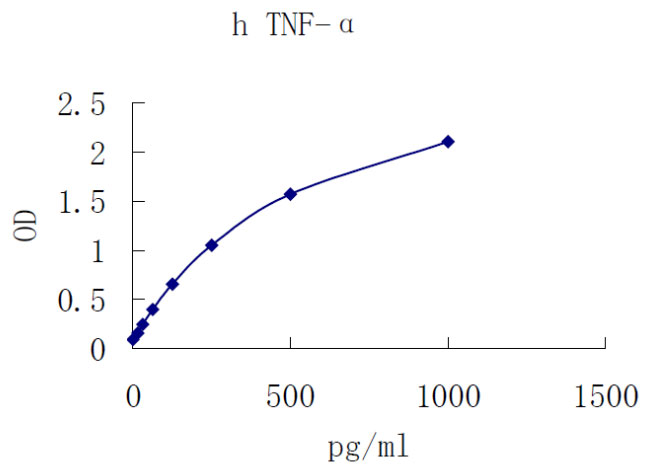Product Detail
Product NameHuman TNF-α ELISA kit
ApplicationsELISA
Species ReactivityHu
SpecificityNatural and recombinant Human TNF-α Ligand
Target NameHuman TNF-α
Application Details
Detect Range: 15.625-1000pg/ml
Sensitivity: 7pg/mL
Sample Type: Cell culture supernatant, serum, plasma (EDTA, citrate, heparin)
Sample Volume: 20 uL
Assay Time: 3 hours
Detection method: Colorimetric
The prototype ligand of the TNF superfamily, TNF-α/TNFSF1A, is a pleiotropic cytokine that plays a central role in inflammation and apoptosis (1-4). Human cells known to express TNF-α include B cells, colonic columnar epithelial cells, NK and CD3+CD56+ hepatic natural T cells, macrophages, monocytes and monocyte-derived dendritic cells, CD4+ and CD8+ T cells, mast cells, neutrophils, keratinocytes, plasma cells, and adipocytes.
It is synthesized as a 26 kDa, type II transmembrane protein that is 233 amino acids (aa) in length (4, 5). It contains a 30 aa cytoplasmic domain, a 26 aa transmembrane segment, and a 177 aa extracellular region (6, 7). TNF-α is assembled intracellularly to form a transmembrane, non-covalently-linked homotrimeric protein. The 157 aa residue soluble form of TNF-α (sTNF-α is released from the C-terminus of the transmembrane protein through the activity of TNF-α-converting enzyme (TACE), a membrane-bound disintegrin metalloproteinase (8, 9).
TNF-α is reported to promote inflammatory cell infiltration by upregulating leukocyte adhesion molecules on endothelial cells, serve as a chemotactic agent for monocytes, and activate phagocyte killing mechanisms (10). Deficiencies in either TNF-α or its receptors can increase susceptibility to infection by intracellular pathogens (11 - 12). TNF- may also play a role in lymphoid tissue development. Knockout mice lack splenic B cell follicles and the ability to form germinal centers (13, 14). Other potential physiological roles for TNF-α and its receptors include regulating the differentiation of hematopoietic stem and progenitor cells (15 - 17).
TNF-α has been implicated in a number of pathophysiological processes. It is associated with unregulated pro-inflammatory activity and is thought to be a critical mediator of endotoxin-induced septic shock (18). Cachexia (or whole body wasting) has also been associated with long-term circulating TNF-α. Other disorders with potential TNF-α involvement include asthma), type 2 diabetes, Crohn
If you have published an article using product EK0459, please notify us so that we can cite your literature.
et al,Characterization of Burkholderia pseudomallei O antigens in different clinical strainsInInt J Biol Macromol.On2023 Jan 15byShengyuan Huo?1,?Xiao Li et al..PMID: 36402383
, (2023),
PMID:
36402383
et al,Clinical Characterization of Serum Docosahexaenoic Acid and Its Relationship With Inflammation Factors in Patients With Diabetic Nephropathy
, (2018),
PMID:
et al,Multifunctional manganese-based nanogels catalyze immune energy metabolism to promote bone repair
, (2025),
PMID:
et al,Nature-derived microneedles with metal-polyphenolic networks encapsulation for chronic soft tissue defects repair: Responding and remodeling the regenerative microenvironment.
, (2025),
PMID:
40026624



 YES
YES



